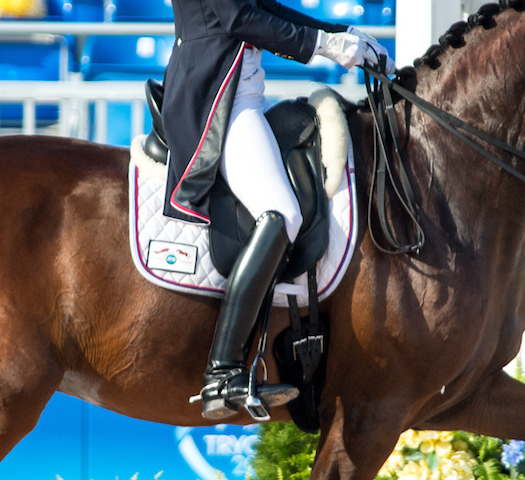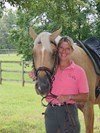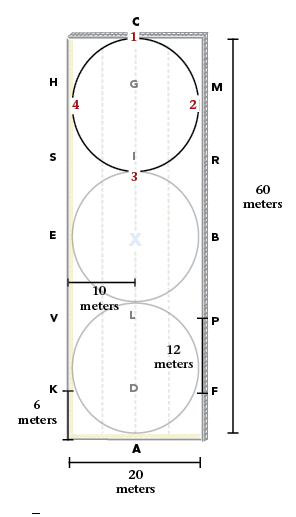Q: Whenever I give a leg aid, I draw up my legs, using my heels instead of my calves. Are there any exercises to keep my heels down? —Angela Erickson of Richardson, Texas
A: First of all, don’t get discouraged. I see a lot of incorrect usage of the heel in dressage riders. It is a common position fault that leads to ineffective or confusing aids. I am a big believer in the importance of basic equitation. Good position is critical and every rider—regardless of experience level—must remain ever vigilant lest he get complacent and begin forming bad habits.

A rider must remember to always keep the line from the ear, shoulder, hip and heel in order to stay balanced on top of his horse. If this line becomes broken (ear in front of the shoulder or heel in front of the hip), then our balance will change, ending up with a seat that is affecting the horse in a negative way. One must let his legs softly drape around the horse without tension in order for the leg to work correctly.
One of the best defenses against complacency is a trusted set of eyes on the ground. An instructor, friend or riding buddy can provide gentle warnings that your heels are “crawling” up the sides of the horse. Now classified as a “vintage” rider, I find that I am not as flexible as I once was and quickly try to correct myself when I sense that I’m not stretching down through the heels as far as possible. My daughter and husband have standing orders to let me know if they see my heels drawn up. Obviously, flexibility can be improved through yoga, Pilates or dedicated stretching exercises.
Here are some exercises you can do to stretch your leg down and lower your heels:
1. One of the techniques I employ is having students work in the “two point” or “half-seat” position. Hunter/ jumpers ride like this. Looking closely at their leg position, you will see they use their calves more than most dressage riders. While they ride with a shorter stirrup that inherently places their leg closer to the horse’s barrel, the same effect can be developed with a dressage rider’s longer stirrup. This requires that you train your ankle and Achilles tendon to be flexible and act like a shock absorber as the horse moves. Only use your calf for sideways or forward leg aids. When I first ask a rider to get in two-point position, she typically rises up on the balls of her feet and stands nearly straight. This is not the proper position for the exercise. Two-point involves barely raising your seat out of the saddle, bearing your weight over your knee, down through your calf, into a deeply stretched heel. I introduce two-point at the walk. After the student finds her balance and can focus on correctly stretching her lower leg, I will have her maintain this position in trot and canter. It’s not easy, but it is effective in training the rider to keep her heels down.
2. A common fitness exercise has you stand on an elevation like a staircase with your heels hanging over the edge of the stair. Allowing your calf muscle to relax and feeling the back of your lower leg stretch will increase your awareness of correct heel position. Placing a large ball between your legs while doing this stretch will reinforce the idea that you can squeeze your calves while simultaneously stretching down through your heels.
3. A simple, classical exercise is performed best on the longe line. Drop your stirrups and draw circles with your toes as you stretch your heels down. Rotate your ankles, making clockwise and counterclockwise circles while concentrating on an elastic calf and lowered heels. When the longe is not an option, perform the same exercise while riding at the walk. You can continue the exercise at the trot or canter as long as you have a trustworthy mount. Of course, don’t try this if you are on a green horse.
An additional consideration is horse and rider suitability. A tall rider on a small horse will always struggle with proper heel position. Horses with a wide barrel will quickly reveal any weakness in a rider’s ability to control her lower leg. The problem is compounded when a rider on a poorly matched horse tries to give proper spur aids. Depending on the calf and heel position, it may be impossible to use the spur unless you bring up your heel slightly or turn out your toes.
Lastly, a poorly trained horse encourages bad riding habits. A horse should willingly respond to light leg aids. It doesn’t matter how much you concentrate on heel position if “Old Ironsides” resists all calf, heel or spur contact. Work on training the horse to be receptive to the lightest touch with the leg and your problem of bringing up your heel will be easier to fix.

Gigi Nutter is an FEI-level rider and a USDF gold medalist who has been on the USET Long List. Her students have received USDF bronze, silver and gold medals. With husband, Scott, and daughter, Cassidy, she trains and teaches at their Touch ’n Go farm in Whitesburg, Georgia (touchngofarm.com).











